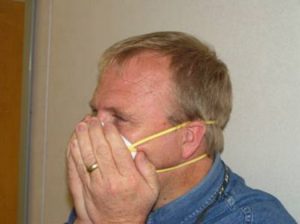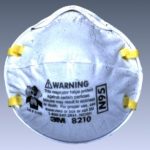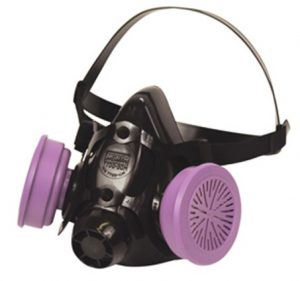
In the aftermath of a storm, your patients may want to clean-up or possibly rebuild their own homes, or participate in other response and recovery efforts, either as individual volunteers or as a member of an emergency response team. You may be asked to review their health status to see if they should be involved in these activities and/or to review their use of respirators/provide respirator medical clearance.
Some patients may develop symptoms during or after participating in clean-up efforts. Determining the possible relationship of these symptoms to exposures, especially mold, at the disaster site can affect treatment and possibly prevent progression of disease.
This section provides general points that you, as a health care provider, may want to consider before your patients participate in clean-up efforts. Additionally, this section contains helpful information for patients that become ill following response and recovery activities.
Is my Patient Fit to Safely Participate in Clean-up Activities?
General Considerations
Whether your patient is fit to safely participate in clean-up activities is a matter of professional judgment based upon your knowledge of his/her current physical and mental health status, past medical history, and the specific hazardous conditions that your patient may encounter. The type of environmental conditions/exposures; the extent/duration of response and recovery activities; the condition of the site; and determination of known and potential hazards should all be considered.
Vulnerable populations:
- Children, frail chronically ill individuals, and pregnant women should minimize their direct participation in mold and moisture clean-up efforts.
- Patients with allergies, especially known allergies to mold (and/or dust mites) or those with a prior history of hypersensitivity pneumonitis, should not participate in post-hurricane clean-up efforts.
- Patients with chronic illnesses, in particular cardiovascular and respiratory diseases, and diabetes, may be at greater risk because of the physical demands of the work, and the additional demands of wearing protective gear. These patients may be more susceptible to harmful effects from respiratory exposures such as from dusts, and chemical or biological materials.
- Individuals compromised by respiratory conditions, may have difficulty using respirators. These and other needed personal protective equipment can increase the physical demands of the work and consequently pose additional hazard to individuals already compromised by cardiovascular and respiratory conditions. (See “PPE/Personal Protective Equipment” below)
- Immune-compromised individuals, for example those with HIV, long-term use of steroids, cancer patients and organ transplant recipients, are more vulnerable to harm from a wider spectrum of biological exposures associated with disasters.
- Individuals with skin conditions, especially of the extremities, are at risk for worsening dermatitis and secondary infections through damaged skin. Wearing gloves and coveralls that are appropriate protective gear when doing this type of work may act to exacerbate existing skin conditions.
- Physical impairments of the musculoskeletal system, in balance, hearing or sense of smell could affect a patient’s safety by limiting ability to maneuver in unstable conditions, to hear warnings, or to detect potentially harmful odors.
- Individuals with mental and emotional health issues can be adversely affected by stress and the difficult task of rescue and recovery efforts.
Additional considerations:
Patient Immunizations
- Immunizations should be up to date and documented.
- The CDC/Centers for Disease Control and Prevention recommends a tetanus booster (Td or Tdap) within the past 10 years.
- Patients whose clean-up activities take place in a building such as a nursing home or other health care facility, may reasonably come into contact with bodily fluids and therefore should be immunized against Hepatitis B.
- Immunizations for Hepatitis A, typhoid, cholera, meningococcal disease or rabies are not routinely recommended.
You should also discuss the following with your patient:
Discuss medication use with your patient.
- Does he/she have an adequate supply while away from home and is appropriate storage available?
- Will the patient be at risk from medication side effects which affect alertness and balance?
Remind patients to be aware of their surroundings.
- Disaster sites can be physically unstable, and conditions and exposures will continually change as clean-up efforts proceed.
- Participants should be aware of nearby activities for example welding and/or demolition which could affect them.
Discuss the additional potential infectious hazards of working in an area where wastewater may have entered the floodwaters.
Remind patients to discontinue clean-up efforts and seek medical attention if they develop symptoms.
Direct your patients to online resources for homeowners, volunteers, and emergency responders located on this UConn Health website and other accredited websites.
After The Storm Mold And Moisture Clean-Up A Guide For Your Safety provides guidance on work practices, selection and handling of personal protective equipment, and personal hygiene appropriate to the amount of contamination your patient may encounter.
Can my patient safely use personal protective equipment?
In the wake of a hurricane or other severe flooding event, exposure to mold is highly likely, especially if activities occur 24-48 hours after the storm, or if the building is located in a humid environment. Individuals participating in remediation or other response and recovery efforts following severe storms should use PPE appropriate to their activities and potential exposures. At a minimum, patients working in damp environments should assume the presence of mold and be advised to use and use a respirator (e.g., the NIOSH-approved N95 respirator is the minimum protection), and eye/skin protection including unvented goggles, long gloves, protective clothing, and reinforced boots (may be available at home improvement centers if not provided by their volunteer organizations). Dust masks and surgical masks do not protect against bioaerosols and should not be used for this purpose!
When considering your patient’s fitness for recovery activities, keep in mind that PPE increases physical demand. This may put the wearer at greater risk for heat- and humidity-related illnesses, and may interfere with dexterity, stability, vision (depending on site conditions) and communication.
What eye and skin protection should be recommended?
Unvented Goggles: If your patient is not using a full-face respirator, OSHA/Occupational Health and Safety Administration recommends unvented goggles for use with an N95 respirator because they protect the eyes against bioaerosols including mold and mold spores, dust, and small particles. Safety glasses or goggles with open vent holes will not protect the eyes from exposures related to mold and moisture clean-up.
Gloves: OSHA recommends long gloves that extend to the middle of the forearm to protect the skin from contact with mold and moisture, and from potentially irritating elements in the environment. Glove material should be recommended depending on the type of materials your patient will come in contact with. Rubber gloves should be recommended for mold clean-up when scrubbing with soapy water, the recommended mold clean-up protocol. However, other glove materials – natural rubber, neoprene, nitrile, polyurethane, PVC, or vinyl gloves should be recommended if a chemical cleaner as chlorine bleach or another strong cleaning solution is going to be used.
Protective clothing: OSHA recommends disposable or reusable personal protective clothing to protect your patient’s skin from coming into contact with mold and potentially hazardous chemicals, and to minimize the transfer of contaminants between work areas and clean areas. When cleaning up medium or large amounts of mold, coveralls with a hood made of a breathable material are recommended. Protective clothing should seal all gaps between the arms, hands, legs, and feet.
Foot gear: Depending on the level of contamination, condition/wetness, or other hazards present, appropriate foot gear may range from booties, rain boots, to steal tipped boots.
What type of respirator should be recommended?
A respirator is the most important PPE. Respirators should be NIOSH-certified and appropriate for specific exposures. When respirator use is mandatory, practices should be compliant with Occupational Safety and Health Administration/OSHA Respiratory Protection Standard 1910.134. This standard outlines a comprehensive respirator program, including medical clearance and respirator selection, fit testing, training and maintenance. Although intended for occupational settings, elements of the Standard may be helpful when determining your patient’s ability to use respirators during storm recovery activities, which do not fall under OSHA’s mandatory rule.
How can a user achieve the best fit?
When use of a respirator is mandatory, Appendix C of the OSHA Standard provides guidance on medical clearance. A questionnaire is provided to help identify medical conditions for example respiratory and/or cardiovascular diseases, which may preclude use of respirators. Note that the questionnaire is intended for medical screening of workers for whom use of respirators is mandatory. However, you may find many of the questions helpful in discussing personal risk with your patient.
If your patient is not already part of a medical surveillance program, physical examination and laboratory studies to determine fitness for respirator use are at the clinician’s discretion and should be tailored to each patient’s situation.
Fit testing is a standardized procedure performed by trained professionals to ensure that the respirator fits a given individual. If a respirator is being used voluntarily, a fit test is not mandatory.
A user-seal check should be performed by the user each time the respirator is worn to be sure it fits properly, and that there is no extra space between the respirator and the face. Proper functioning of negative pressure air-purifying respirators such as the N95 is critically dependent on a tight seal between mask and face! You may wish to refer your patient to an Occupational Health Clinic and Certified Industrial Hygienist for respirator medical clearance and fit testing.
Factors affecting proper seal include:
- Individuals with facial hair cannot be fitted to use N95s or other negative pressure air-purifying respirators. If a respirator is recommended for use during any given activity, facial hair should be removed. Alternatively, a loose fitting powered air-purifying respirator would be protective, but is often not practicable.
- Facial scarring, facial deformity, or recent facial surgery may disrupt the seal necessary for effective protection.
- Respirators come in many types and sizes to accommodate different faces. However, it can be difficult for children to get a proper seal due to respirator size issues.
Other factors with the potential to interfere with safe use of respirators:
- Failure to perform a user seal check each time a respirator is put on.
- Anything in between the face and the respirator (facial hair, body piercing, eyeglasses, handkerchief, etc.)
- Impairment of sense of smell when using the respirator may render the user unable to detect potentially harmful conditions.
- Incorrect respirator size

OSHA Video: How to Perform a User Seal Check with an N95 Respirator
The descriptions below have been adapted from OSHA/Occupational Health and Safety Administration
N95 Respirator:

OSHA ImageAn N95 respirator is the minimum protection recommended for mold clean-up. This respirator is tight-fitting, air-purifying, 95% efficient when worn properly (this respirator should be fit checked by an industrial hygienist unless it is worn under voluntary use conditions), and protects against particles (e.g., mold). It does not protect against non-particulate hazards such as gases or vapors (e.g., carbon monoxide, or chemical cleaners). This respirator is commonly used, readily available, reusable and disposable. It should be replaced when breathing resistance occurs. N95 respirators may look like a dust mask – Be sure they are labeled N95 and have bands to hold the mask close to your patients face.
Half-Facepiece Elastomeric Respirator:

This is a half-facepiece elastomeric respirator. It is a tight-fitting, air-purifying respirator with replaceable filters (for particulates) or cartridges or canisters (for gases and vapors). In either case, these are attached to a rubber or silicone facepiece that covers the nose and mouth. This respirator can be used instead of a filtering facepiece respirator. An industrial hygienist must fit check this type of respirator unless it is worn under voluntary use conditions. An elastomeric half-facepiece respirator can be cleaned, decontaminated, and reused. This is not the case for a filtering facepiece respirator, which is normally discarded after use.
Full Facepiece Elastomeric Respirator:

This is a full facepiece elastomeric respirator. This type of respirator provides a higher level of protection than a half-facepiece respirator because it has better sealing characteristics. Since it covers the user’s eyes and face, it can also be used to protect against liquid splashes and irritating vapors. Like the half-mask elastomeric respirator, this respirator is a tight-fitting, air-purifying respirator with replaceable filters or cartridges attached to a rubber or silicone facepiece. An industrial hygienist must fit check this type of respirator unless it is worn under voluntary use conditions.
Are My Patient’s Symptoms Related to Mold?
Individuals are exposed to a wide variety of physical, chemical and biologic hazards at disaster sites. In the wake of a hurricane or other severe flooding event, exposure to mold is likely significant, especially if response and recovery activities occur 24-48 hours after the storm, or if the building is located in a humid environment. This section specifically addresses the health concerns arising from such mold exposures.
General Considerations
- Where there’s water, there’s mold. Damp environments are the settings where mold flourishes. Assume mold exists, especially 24-48 hours after the event.
- Routes of exposure are primarily respiratory and dermal.
- The extent, duration and types of activities affect exposures.
- Both living and dead fungi can induce symptoms and/or illness.
- Although some individuals may be more susceptible to developing mold-related illness (e.g., atopic individuals, asthmatics, immune compromised patients), healthy individuals are at risk as well.
Health Effects of Mold
Mold-related symptoms and illnesses look like non-mold-related symptoms and illnesses.
There may be a delay between exposure and onset of symptoms.
Molds can produce both irritant and allergic symptoms/illnesses. Recognized associations include:
- Ocular: conjunctivitis
- Upper respiratory:
- Rhinitis, rhinorrhea, nasal congestion, sneezing, sinusitis, irritable larynx syndrome
- Hoarseness and throat irritation
- Lower respiratory:
- Cough, wheeze, shortness of breath, chest tightness
- New-onset asthma, exacerbation of pre-existing asthma, hypersensitivity pneumonitis
- Inhalation fevers: humidifier fever, organic dust toxic syndrome
Evaluating the Patient with Possible Mold-related Illness
- Patients may not associate their symptoms with mold exposure or think to report exposures to mold; therefore the clinician must maintain a high index of suspicion for mold exposure given the scenario of recent wet weather activity. The patient should be queried regarding storm-related exposures or activities (types, extent, duration and setting), whether protective equipment was used, and any known or possible exposures, including mold.
- Diagnostic testing should be guided by the differential diagnoses under consideration.
- Testing indoor air for mold contamination is not recommended. (The World Health Organization 2009 review noted that observations of visual mold and/or moldy odors correlated with health symptoms, but measurements were less reliable.)
Treating the Patient with Mold-related Illness
- Removing patients with suspected mold-related illness from contaminated environments can be diagnostic as well as therapeutic.
- The patient should immediately suspend any activities generating exposures to mold.
- Standard treatment regimens can be applied as appropriate.